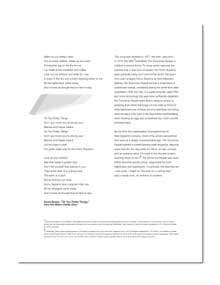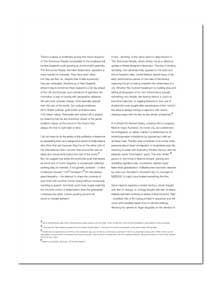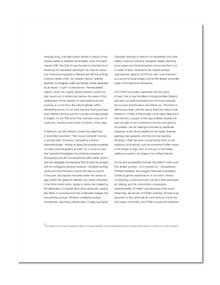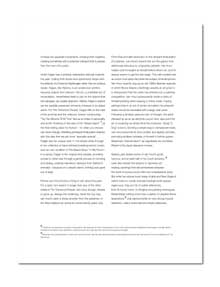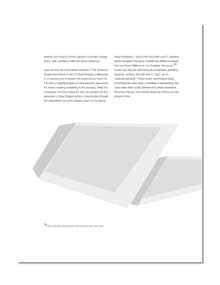 |
|||||||||
|
|
| ...PUBLICATIONS | ... Oh You Pretty Things | ||||||||||||||
|
Wake up you sleepy head Oh You Pretty Things Look at your children from the album Hunky Dory This song was released in 1971, the year I was born. In 1974, the BBC[1] premiered The Tomorrow People, a children’s science fiction TV show which explored the premise that a new race of people, the Homo Superior, were gradually being born around the world. Set apart from plain wrapper Homo Sapiens by their telepathic abilities, the Tomorrow People formed a small band of undercover heroes, constantly saving the world from alien exploitation. With the help of a supercomputer called TIM, and some technology that was never sufficiently explained, the Tomorrow People were able to teleport simply by grasping their rather fetchingly chunky belts (a friend of mine fashioned one of these out of a matchbox and string when he was a child, back in the days before merchandising, when blowing an egg was considered top-notch juvenile entertainment). By the time this masterpiece of programming hit New Zealand’s screens, most of the artists represented here were at a deeply impressionable age. The Tomorrow People boasted a surreal opening credit sequence, featuring super fast (for the day) edits of a fetus, an eye, a flower, and an opening hand, (“A crack in the sky and a hand reaching down to me”). 2The Tomorrow People was every child’s favourite spooky show, responsible for both nightmares and daydreams. In particular, the idea that we - the youth - might be “the start of a coming race” was a heady tonic, an antidote to isolation. There’s a sense of loneliness among the Homo Superior of The Tomorrow People comparable to the loneliness felt by New Zealand’s youth growing up on the world’s periphery. The Tomorrow People, like New Zealanders, represent a mere handful of humanity. They have each other, but they are few, so, despite their innate superiority, they are vulnerable. Growing up in New Zealand, where today is tomorrow (New Zealand is a full day ahead of the US and Europe), such delusions of grandeur are normative, a way of coping with geographic distance. We are more uniquely unique, more specially special, than the rest of the world. Our cultural loneliness (90% British colonial, guilt-ridden and flavourless, 10% Maori native, Polynesian and pissed off) is abated by believing that we are somehow ahead of the game. Isolation makes us the bosun in the crow’s nest, always the first to sight light or land. I do not mean to do the artists of this exhibition a disservice by presenting them as a vainglorious bunch of Antipodeans who think that just because they live on the other side of the International Date Line that they encounter new art ideas and movements before the rest of the world. 3 But I do suggest that artists the world over posit themselves as some sort of Homo Superior, a consensual collective working daily on memetic, if not genetic, evolution - a tribe of Macaca fuscata (“100th monkeys”). 4Art has always aped telepathy - the attempt to share the contents of your brain with another human being without necessarily resorting to speech. And what could more closely resemble the futuristic notion of teleportation than the peripatetic contemporary artist, forever jaunting around the world on funded junkets? In fact, “jaunting” is the name given to teleportation in The Tomorrow People, which strikes me as a delicious update of Walter Benjamin’s flaneurism. The idea of strolling, rambling, inter-dimensionally, appeals to the artist and Homo Superior alike. Daniel Malone based many of his early performance pieces on the idea of the flaneur, exploring the art of losing oneself in the wilderness of a city. Whether this involved breaking in to building sites and taking photographs of his own interventions (usually something very simple, like leaving behind a clutch of boy-blue balloons), or tagging (Malone is now one of Auckland’s most sought-after perpetrators of this “crime”), the artist is always tracing a trajectory with action, drawing maps with his feet (a very simian enterprise). 5 In A Street Kid Named Desire, a feature film in progress, Malone maps Auckland, his home city, as a wilderness for immigrants, or rather, makes it a wilderness for its white/polynesian inhabitants by populating it with an all-Asian cast. The film was conceived of at a time when paranoia about Asian immigration in Australasia was rife, reaching its peak with Australia’s Pauline Hanson and her blatantly racist “One Nation” party. The only “white” 6person in the movie is Malone himself, gaining and shedding signifiers (hair, moustache, slanted eyes) faster than globalization. If Bladerunner had been directed by Jean-Luc Goddard in Auckland city on a budget of NZ$5000, it might have looked something like this. Gavin Hipkins explores a similar territory; desire fraught with fear of change, or, change fraught with fear of desire. Hipkins has been working on series of what he terms “falls” - unedited rolls of film being printed in sequence and left uncut and unedited (apart from in-camera editing). Allowing his camera to linger languidly on the detritus of everyday living, from light-switch fixtures to pieces of fruit, Hipkins seems to fetishise the simplest, most “innocent” objects. With The Gulf, he ups the ante so that there is no mistaking the sexualized yearning of his mise-en-scene: now Internet pornography is interspersed with the achingly irrelevant details of life. Yet, despite Hipkins’ ardently aesthetic co-minglings, reality and fantasy remain separated by an abyss - a gulf - a blue lacuna. The sexualized objects, which are roughly spliced between women-for-sale, serve only to remind and reprove the viewer of the uselessness of their desires. A coiled telephone cord puckers up on the floor, like a Burroughsian orifice demanding succor. It is at once obscene, funny, and sad. Here, Barthes’ famous punctum sounds more appropriate in English, it’s the “little prick” that animates every act of voyeurism, haunting every frame of Hipkins’ erotic saga. If Hipkins is, as critic Robert Leonard has called him, a “poet after Auschwitz,” then Joyce Campbell must be a scientist after Chernobyl. Campbell is a fervent phenomenologist - finding out about the physical properties of matter via photography and film. Or, it could be said that Campbell investigates the physical properties of photography and film via experiments with matter, and it’s just such slippages of perspective that the artist encourages with her ambiguous abstract surfaces. Campbell carefully constructs environments in which she has no control: in the past, she injected microbial matter into sheets of agar, which then grew into delicate, lacy doilies of bacteria. In her most recent series, figures in motion are created by the distribution of colloidal silver off an electrode, creating fiery flares, in counterpoint to the underwater imagery she concurrently pursues. Whether crystalising sodium thiosulphate, dissolving colloidal silver, or deep sea diving, Campbell attempts to teleport our sensibilities into other realms: chemical, physical, biological, digital, exploring every sphere but the stratosphere, and surely that’s just a matter of time. Campbell is the original abstract expressionist, tapping not into her own “subconscious” as a source for lyrical imagery, but into the deeper, primordial urges of the elements themselves. Ani O’Neill moonwalks backwards into the future. At least, this is how the Maori of Aotearoa/New Zealand see time: you walk backwards into the future because all your past and ancestors are before you. The future is behind your back, and the past is what you have to look forward to. O’Neill, of Rarotongan (Cook Island Maori) and Irish descent, is aware of this responsibility towards the past and also of the nourishment that the past gives to the present. Her art making is informed by traditional practices: ei katu (floral wreaths for the head), tivaevae (applique bed spreads), and hat and mat weaving. Recently, O’Neill has been concentrating more on the traditions of homecraft, such as crochetted bottle-covers in the shape of dogs, and, for the year of the Snake, cellphone covers in the shape of our slithery friends. Humor and accessibility motivate this artist to make work that literally touches - or is touched by - the audience. In Bright Paradise, the inaugural Triennale of Auckland, O’Neill taught the traditional art of crochet to visitors, constructing a communal work over time. Multi-participant art making, and the concomitant conversation, decentralization of “talent” and dissolving of art world hierarchies, are all part of O’Neill’s practice. Process is as important to the traditional art community as it is for the post-object community, and O’Neill occupies the interstices of these two separate movements, bringing them together, creating something with a potential outreach that is greater than the sum of its parts. Violet Faigan has a similarly redemptive attitude towards the past. Culling thrift stores and opportunity shops with the attitude of a Florence Nightingale rather than an antique dealer, Faigan, like Hipkins, is an undercover animist, rescuing objects from oblivion. Her art, a charitable act of resuscitation, nevertheless feels no pity for the objects that she salvages; pity implies abjection. Rather, Faigan’s objects are the carefully preserved remnants of beauty in an abject world. For The Tomorrow People, Faigan riffs on the idea of the archivist and the collector, forever constructing “Top Ten Albums Of All Time” lists as an index of personality and worth. Punning on the idea of the “desert island” 7as the final resting place for fashion - for what you choose can never change. Wedding archetypal Antipodean isolation with the idea that we are more “specially special”, Faigan lets her unique rock ‘n’ roll smarts shine through in her collection of hand-stitched toweling record covers and her own rendition of The Beach Boys’ “In My Room”. In a sense, Faigan is the original time traveler, providing access to other eras through a gentle process of combing and styling, creating marvelous tableaux from fashion’s amnesia - because on a desert island, nothing ever goes out of style. Ronnie van Hout knows a thing or two about the past. For a start, he’s lived in it longer than any of the other artists in The Tomorrow People. Van Hout, though, refuses to grow up. Always the underdog, never the top dog, van Hout’s been a sharp-shooter from the periphery of the New Zealand art scene for some twenty years now. From Elvis and alien abduction, to the rampant eroticisation of potatoes, van Hout’s oeuvre has run the gamut from deliciously ridiculous to poignantly pathetic. Van Hout makes sure he laughs at himself before others do, and he always seems to get the last laugh. This self-created role as a kind of art-joker becomes the subject of his lampoons. Van Hout recently dug up an old 1960s Batman episode in which Bruce Wayne unwittingly awards an art prize to a chimpanzee that the Joker has entered into a painting competition. Van Hout subsequently made a video of himself painting while wearing a chimp mask, hoping perhaps that in an act of simian simulation his artworld status would be rewarded with a large cash prize. Following a similarly obscure train of thought, the artist dressed up as an ex-alcoholic pooch who discovers the art of sculpting via rehab (thus the character “Sculp D. Dog” is born). Donning a simple dog or chimpanzee mask, van Hout becomes at once sinister and slightly futuristic, promising endless remakes of himself in further guises Nieztche’s “eternal return” as negotiated via countless Planet of the Apes television movies. Saskia Leek shares some of van Hout’s goofy humour, and at least half of his Dutch ancestry. 8Leek also eludes the spectre of “growing up”, making paintings that fall somewhere between the work of a precocious child and a backwards adult. But while her picture-book vistas of girls and New Zealand native birds on candy-coloured backgrounds appear ingenuous, they are full of subtle references, from B-movie horror, to Moghul-era painting techniques. Resembling nothing more than a series of Ladybird Book illustrations, 9only painted while on very strong muscle relaxants, Leek’s world exhorts simple pleasures, whether your drug of choice happens to be jelly crystals [trans. Jello crystals] or Mills and Boon romances. Leek and the rest of the artists exhibited in The Tomorrow People demonstrate a kind of cultural tenacity, a willingness to re-process and re-present the world around them, as if to train a magnifying glass on their favourite views (even if it means singeing something in the process). While not necessarily the Homo Superior, they are perhaps the first generation of New Zealand artists to have broken through the regionalistic fog which presses down on this island nation (Aotearoa = “land of the long white cloud”). Jaunting around the globe, this group of artists are settling in pockets here and there: Melbourne, Los Angeles, Vancouver. 10 In each city, they mix with their local counterparts, exhibiting, studying, working, learning how to “pass” as an “international artist.” These artists nevertheless share something with each other, a wordless understanding, that does make them subtly different from artists elsewhere. Wherever they go, their internal clocks are ticking one day ahead of time… Tessa Laird Footnotes 1Being loyal subjects of Her Majesty, New Zealanders are also subject to the British Broadcasting Service. As time passes, Americanization of our airwaves is (not so) slowly taking over. But there exists a generation in between with an unusual cultural schizophrenia, half-British, half-American, of which the artists represented in The Tomorrow People are prime examples. 2Interestingly, Gavin Hipkins superimposed Le Corbusier’s sculpture of an open hand with images he took in the Chandigarh rosegardens in The Trench, an installation of slides shown at the Physics Room in 1998. Even curiouser, the Tomorrow People’s title sequence featured two shots of the cross section of a capsicum [trans. bell pepper]. What deeply significant import this had I am not sure, but certainly many of Hipkins’ equally random-seeming objects are as likely imbued with deeper symbolism. 3One of Daniel Malone’s early works involved having a stamp made up with the words “It was my idea first” which he then proceeded to apply liberally to various surfaces. 4In this case then, New Zealand operates as a kind of ersatz Koshima Island - a hot bed of hot pools, kumara [trans. yams], and primates with big ideas. 5Feet are also the special province of Picies, which is Malone’s sign, and the title for a performance undertaken in the Chung King Road wishing well in 1999, in which two fish were added to the pond with the whimsical hope that at some point, they would swim towards each other from opposite directions, taking the simulacrum of the “Picies” emblem back to its fishy origins. 6Malone is supposedly, infamously, “of Cherokee descent.” 7New Zealand is by no means a topographical desert, but by global standards, it’s somewhat deserted, having a landmass similar to Japan’s, but still less than 4 million inhabitants. 8Though she can scarcely be accused of Tulipomania, Leek does dip her hand in the bloempot once or twice, enjoys a liberal smattering of floral imagery, and after gaining notoriety for her sketchy paint application, recently proved to be a dab hand with still lives and lacquer by the gallon. 9Remember the Ladybird Books? In which each scene from each fairy tale was painted by perfection seemingly by the same team that work for Komar and Melamid and The Watchtower. 10“All the nightmares came today/And it looks as though they're here to stay”. This essay originally appeared in The Tomorrow People Catalogue Published 2001 Wholesale: $6.00; Retail $10.00 ISBN# 0-473-08158-X 24 pages, 7 colour plates Order your copy today from The Physics Room !
|
||||||||||||||

